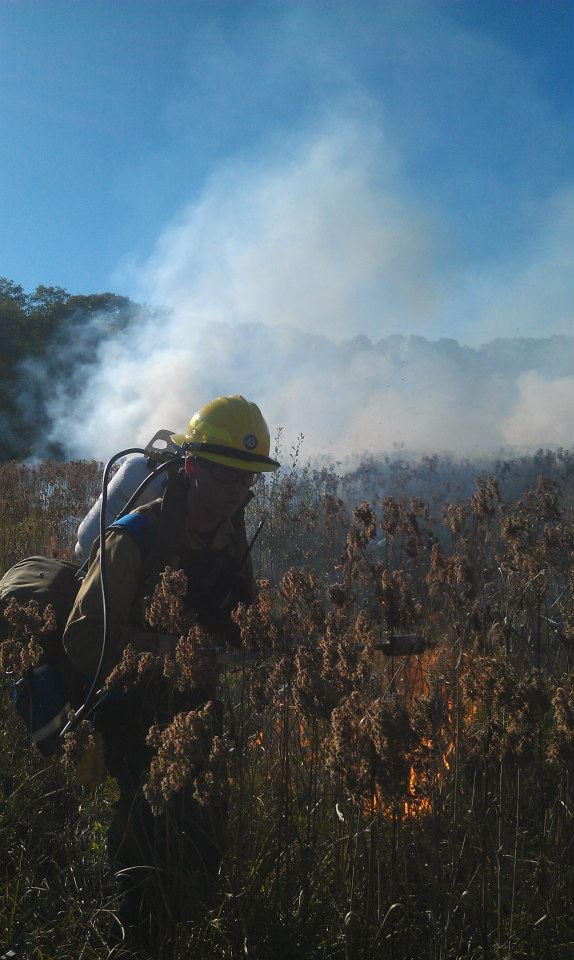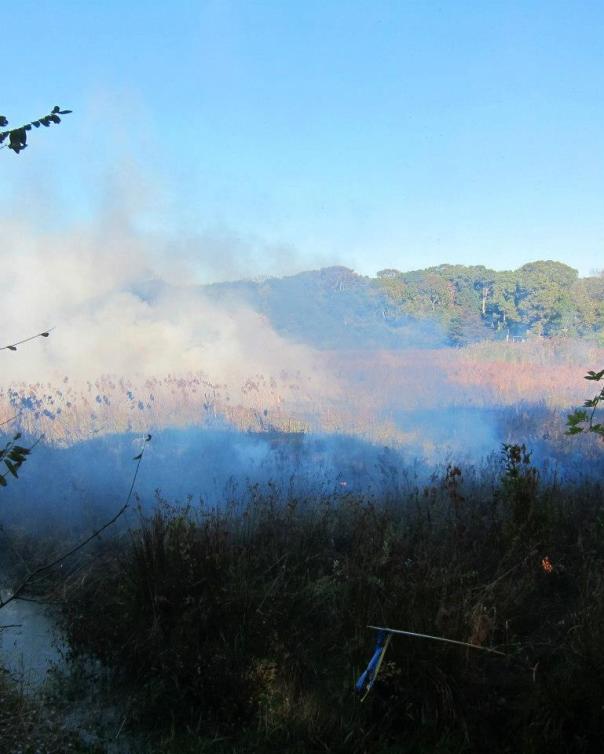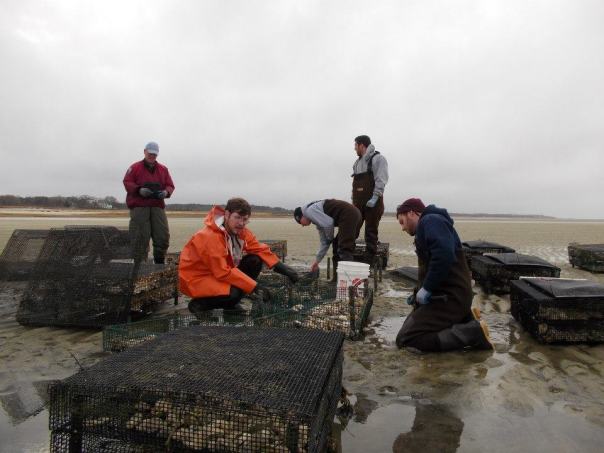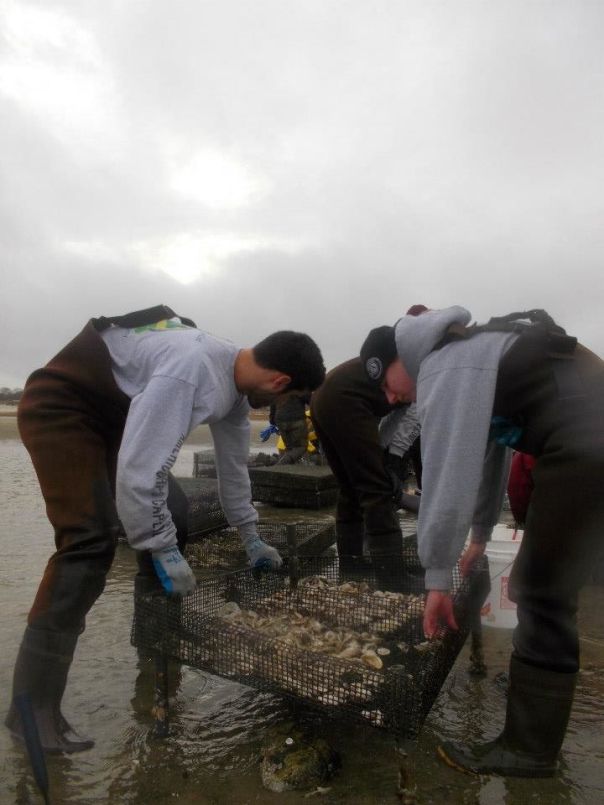Monthly Archives: December 2012
Twas the week before Christmas
And Cape Cod is still a ghost town. I really do like this place, especially as empty as it is these days. From what I’ve been told, we have another four or five months of quiet before the vacation season really kicks off properly.
This week was spent completing our chainsaw training with the Cape Cod National Seashore. We started S-212 (Wildland Fire Chainnsaws) over a month ago, but Hurricane Sandy interrupted our training and we weren’t able to finish it before we split off from working primarily with the Park Service. I’m planning on writing a more in depth account of what S-212 contained for us over the next few days. For now, I’ll just share a few pictures from the week.

Luckily for us, the Cape Cod National Seashore has a location right across the street from our house they’ve been wanting to thin for a few years now.
In brief, we spent the entire week cutting down Pitch Pines in the forested lot across the street from our house. The idea was to kill two birds with one stone, we needed chainsaw training so that our bosses within the Park Service could trust us not to cut off our own legs using their chainsaws and the Park Service needed the Pitch Pines near our house thinned out so they’d be less of a fire-hazard.
Mission Accomplished, I guess. We cut down somewhere in the neighborhood of sixty trees over the course of three days, which opened up the canopy and gave us plenty of firewood. We don’t actually have a fireplace to burn it in (its just as well, since Pitch Pine isn’t really the best ‘indoor’ firewood), but had the world actually ended on the 21st we’d have been set.
The other big project this week was turning our garage from a place that looked like a tornado made of power tools had touched down to an actual shop.
Working right by home was nice I guess. I’m just happy we finally got that training finished up. We’ll be using chainsaws alot over the next few months.
Not the Princess Bride’s Fire Swamp: Prescribed Burn 3
Our third prescribed burn this year was scheduled for October 18th. The goal was to burn a several acre cranberry bog at the behest of the owners of the Dry Swamp Bog organic farm in Orleans. They seemed to be of the opinion that burning the bog would clear out a variety of undesirable species that they didn’t want to control using herbicides while also reinvigorating the soil.
Never having done something like this before, and having a minimum of terrestrial farming experience, I was initially skeptical that we’d even be able to get the fire started (Bogs aren’t exactly on my top 10 list for ‘most flammable places’). On the other hand, I’m all in favor of reducing herbicide use (especially in wetlands areas) when possible, and was completely willing to give them the benefit of the doubt.
At any rate, after loading three trucks and a fire engine with all the gear we’d need to light a bog on fire, we set out and arrived on the property before noon. The first thing we noticed (as we should have) was that the entire bog area sat only a few inches above the waterline.
Ok, that shouldn’t have been a surprise. The area we were to burn was surrounded on three of four sides with trenches that were full of water. Those trenches formed natural control line, although as we found out, they weren’t perfect.
Sizing up the property our boss found one place in particular, a corner where there were nearby structures, that deserved extra protection and parked out one fire engine there on the off chance a few unlucky firebrands crossed water filled trenches.

Our very-nearly-mandatory pre-ignition group photo. The brown stalks in the foreground were actually the only vegetative matter in the bog that burned consistently. The cranberry bushes certainly didn’t. Which, come to think about it, was probably just what the farmers wanted.
Due to the nature of the cranberry bog: the wet, the shade covering half of it, the sparse/low vegetation. We were to use fusees (effectively longer lasting road flares used to ignite material by hand) and a handheld torch fueled by a backpack mounted propane canister We also had four backpack pumps that we were to use for control and mop-up after the burn.

Having the propane canisters mounted on our backs saved us the trouble of lugging them around on dollies. However it did mean that we had to ditch our IA packs. The torches were lit manually, using the conveniently provided strikers we ended up tying to the frames.
As we’d feared/expected, the bog didn’t burn particularly well. The bearers of the two torches walked back and forth across the burn area using the long-handled flamethrowers to place dots of flame every 10 feet or so, creating a tight grid of small burning patches. The rest of us helped fill in the remaining space by using the fusees to light particularly promising patches of dried plants and by physically moving flaming material into green (unburned) territory.

How sweet does this look?! Seriously, its lucky we brought these along, the fall sun wasn’t really putting out enough heat to make our job easy.

Here Matt is ‘dotting’ the burn area. Behind him the dots of fire he’s laid down already are creeping along the ground.

Some of the plants in the bog, like this Pitch Pine sapling, simply weren’t going to ignite on a day like the one we were burning on. It would have taken a much more intense fire on a much drier day to get the pine in this picture to burn.
The only snag came when, as the burn boss had predicted, a few firebrands made the jump across the trench near the lone structure adjacent to the bog. There they burned merrily for nearly a minute before they were drowned by a fast acting firefighter standing by the engine’s internal pump. I wish I’d been nearby to get pictures of that sequence of events, but I was busy carrying burning grass around on the other side of the bog at the time and only heard about it over the radio.

The flames were low for the duration of the burn. Again, the effect of the sun on the fire’s intensity was pronounced, as you can sort of see in this picture.
Mop up was minimal after such a low intensity blaze, but we still spent the better part of half an hour at the end of the day extinguishing every last whisper of smoke that had been rising from the field.
As I mentioned above, the only fuels in the burn area that consistently ignited were the tall brown stalks. The cranberry plants themselves were pretty much immune to the attentions of the propane torches. While this made for a somewhat low-key experience from my perspective, I can’t help but think that the end result of the prescribed burn was fairly close to what the farmers that had asked for our help had hoped would happen. It will be interesting to see how this property recovers in the spring.
Shellfish farming: Wetter than plant farming.
Let me preface this by saying I know pretty much nothing about the mechanics of oyster-farming. Aquaculture in general is something that interests me, but there’s only so many hours in a day to split between work, my daily ablutions, and trying to learn new things.
However, because I’m interested in the process, I was happy to get a chance to help the town of Brewster maintain their oyster grant this past week. The oysters grown in the cages we were fixing are used during the recreational oyster catching (collecting?) season. During the warmer months, the town of Brewster takes the oysters they grow and scatters them in areas designated for recreational collecting (harvesting?) The result is something like a cross between an easter-egg hunt, going apple picking, and a day at the beach. The oysters, which in the wild grow attached to a hard substrate, are simply plopped down in the water in the collection area to await their gristly demise. The plus side of the whole equation is that by providing people interested in collecting shellfish with a place to do so, the town is able to justifiably restrict access to other potential oyster habitats in the area. Again, I don’t know much about the mechanics of fishery maintenance. But on the surface, that seems like a good idea.

This picture was taken about twenty minutes before the storm arrived. Once it showed up I went from looking fairly well put together to looking like a drowned cat in all of five minutes.
Our job was to help repair some of the cages that the oysters mature in. Salt water corrodes everything, and the nails that helped keep the cages together were – in some cases – more rust than substance. I got to put on waders for the first time in almost a year and splash around for a few hours. An unexpected rainstorm put a little bit of a damper on the afternoon, but I’ve long since past the point where getting wet at work bothers me.

Patrick, the member in the bright orange jacket, was apparently the only one of us who thought to check to the forecast. Oh well.
The entire process only took about two hours, which makes sense since we were limited by the tides. At high tide the cages are covered completely and our job would have been considerably less pleasant.
Hopefully I’ll have another chance to learn more about the process by which these (arguably) delicious suckers are grown and distributed. The rain, and the nature of the work kept me from being able to ask all of the questions I had at the time.
This week in pictures
Living in a real house (as opposed to living in a screened porch on a pavilion on a small island) means I actually have internet access every day of the week and I’ve been meaning to take advantage of this by posting more photographs. Unfortunately, the nature of the work I’ve been doing for the past few months has really discouraged me from taking my camera out with me. So — despite being ‘able’ to post more pictures — I haven’t actually taken many pictures worth posting.
I think I can manage posting a couple decent shots per week though. Realistically, most of what I’m doing doesn’t make for astounding photography, but I think I get enough exploring done to make for some interesting posts.
This week we split our time between four different projects. We worked in Nickerson State Park, repairing washed out fire roads, on Wing Island in Brewster, in a ex-cranberry bog being maintained by a local conservation organization, and at the town of Brewster’s shellfish grant.
The mission on Wing Island hasn’t changed, we’re still mowing down acres of brush to prep the area for a prescribed burn next spring/summer. At last check the total area we’ve treated in the last two months (working maybe one day a week on average) is approaching six acres. There’s still a ton to mow, but we’re making progress.

Wing Island is only an island at high tide. Luckily, we’re prepared to make the trip out to the project area even when the moon isn’t cooperating.

At this point, we’re all fairly eager to be finished on Wing. It seems like we’ve been working there forever and we’re looking forward to the promised payoff.
Although I’ve been living on Cape Cod for the past three months (or something like that) this week was the first time I’ve visited Nickerson State Park. The park itself is enormous, and is cris-crossed with fire roads to allow local fire departments to move engines and other resources easily to the site of any fire-event. We worked to help keep those fire-roads in decent shape by repairing a pair of washed out sections and replacing a damaged water bar.

I’m looking forward to coming back here once its warm out again. This weather and I don’t really get along.
Finally, we spent the early part of this week helping to remove pines from a recently retired cranberry bog near Brewster. While the organization that is maintaining the bog hasn’t decided on what community they plan on promoting there yet, they know that Pitch Pine isn’t a species they’re concerned with fostering.
Burning up Cape Cod (Prescribed burns 1 and 2)
Despite this past fall being uncommonly wet (though far from dreary), we did manage to help with a few prescribed burns on the Cape Cod National Seashore. The first, our training burn, took place on a set of research plots one of our managers has been maintaining since the late 80’s.
Plots in this area are either burned or mowed at different intervals. We were starting burns on two of the shorter interval burn plots. Both were small burns, as these things go, neither more than 1/10th of an acre. Even so, our boss from the Seashore kept us in full firefighting kit the entire time.
For this small burn we started by making a scratch line — a thin strip without potential fuel in it — around the edges of the burn area using rakes. Then half of us crossed back and forth within the burn area using drip torches to light parallel lines of fire on the forest floor while the other half patrolled the scratch line with backpack pumps dowsing the flames as they reached the edge.
Drip torches (the metal canisters on the ground in the picture above) are carried at arms length and lay down a line of burning gasoline and diesel fuel. On this particular burn, having a consistent source of ignition was useful, both because of our inexperience and because the dappled shade and low fuel load at the site made it more likely that we wouldn’t be able to get a complete burn on the plot.
The affect of sunlight on fire was something I was under-aware of prior to coming to Cape Cod. The effect was particularly noticeable on this burn, where burning fuel in the shade simply wouldn’t spread as far as that which was spilled in the sun.
Because these plots had been burned so frequently, every other year in fact, there wasn’t much fuel on the ground. The flames from the fires we started here never grew to be more than about a foot. We mopped up using backpack pumps, making sure that there wasn’t so much as a whisper of smoke still emanating from the ground before we packed in for the day.
Serving with the Cape Cod National Seashore (Caco)
As I mentioned in an earlier post, I’m currently serving with Americorps Cape Cod and with the Cape Cod National Seashore. Specifically, I’m serving (working, whatever) as a member of the Americorps Fire Crew that was started just this year. The Americorps Cape Cod program has been in existence for the past 14 years and during that time they’ve made connections with just about every conservation organization on the Cape. The Cape Cod National Seashore is one such organization.
In previous years only one or two Americorps members would serve with the Seashore. That approach worked well, but the powers that be decided that it would be even better to have a dedicated group of individuals working ‘only’ as a fire crew throughout the entire service year. All 11 months / 1700 hours of it.
(I’m still pleased as all get out that I have a contract that lasts 11 whole months!)

Wells House at Marconi Beach, Cape Cod. Home of the newly formed Americorps Fire Crew. Pretty sweet digs.
It apparently took awhile to get the necessary grants together, but as of September of this year all the ducks were finally lined up and we were taken on in a flurry of applications and interviews.
Since this is the Fire Crew’s first year in existence, quite a bit of our purpose is still up in the air. Clearly we’re meant to help the Cape Cod National Seashore with their ongoing prescribed burning of their own holdings, but there’s some question as to how far afield we can travel with them if they get called to an incident elsewhere in the country.
Obviously, Cape Cod is not known for its large scale Wildfires, however most of the Cape’s forests are dominated by Pitch Pines, a very fire tolerant species of tree that burns readily (read: at the drop of a hat). The Parks Service Fire crew splits their time alternating between travelling around the country working on wildland fires elsewhere and enacting prescribed burns on Cape Cod itself.
While on the Cape our tasks more often involve fuel reduction (physically cutting down and removing dead trees and brush) with occasional prescribed burns. Both of which are aimed at promoting a desired ecology by recycling nutrients, removing non-desired plant species, and creating habitat for animal species.
For instance. Below is a picture of Wing Island in Brewster Massachusetts. Wing Island is typically mowed once a year in order to promote early succession species — grasses, shrubs, and the like. Normally, that mowing treatment is carried out during the winter, when the cold weather freezes enough of the marsh surrounding the island to allow a tractor access. Unfortunately, it never got quite cold enough last year to provide the tractor with safe passage. Because of that, there was a massive spike in the number of woody plant species growing in the area. In the picture below we’re pre-treating the area in preparation for a burn there this coming Spring/Summer.

In the foreground the dried out layer of brush we cut previously is visible. This project has been ongoing for the past few months. Unfortunately, there’s still a ton to do before its adequately prepped for burning
By cutting down the grasses and shrubs that have grown up over the fields on the island we’re creating a continuous horizontal fuel layer, which will burn more readily than had we simply left things in state.
This sort of work constitutes a large portion of what we’ve been doing for the past few months. This fall was uncommonly wet, which unfortunately prevented us from lighting as many prescribed burns as our managers would have liked. However, although these projects aren’t as exciting as the burns tend to be, the naturalist part of me still finds them (if not engaging) satisfying.
Bound for Cape Cod
I prefer to write the entries on this blog with the benefit of hindsight. There are a few reasons for this but chief among them is that waiting a few weeks or a month after an event — be it accepting a new job, moving somewhere new, or completing some novel task — helps me to separate the wheat of the experience from the chaff. The major downside to this strategy is that by the time I decide a set of experiences is actually post-worthy they have faded in my memory. Keeping a journal has helped me a lot with recalling specifics, but it seems like I need a better way of approaching things.
At any rate, its been a few months since I’ve last posted on my whereabouts. In part this is due to the reasons I’ve mentioned above, but its also because between my new job, my current class load, and my desperate desire to sleep on occasion I don’t have a lot of spare time to devote to entries.
I worked at the Stewart B. McKinney National Wildlife refuge until September of this year. I had a fantastic time as an Island Keeper on Calf Island and it was great to be able to (at the end of the season) use the skills I’ve developed with ArcGIS to create a map showing Calf Island’s invasive species populations.
At the end of August I received an email from one of my bosses at the refuge with a job opening attached. Through a previous boss of her own, she’d heard that the Americorps Cape Cod organization was piloting a new program, a Fire Crew that would be working extensively with the Cape Cod National Seashore, and needed warm bodies to fill the spaces that were remaining.
I jumped at the chance. I’ve always found fire-ecology fascinating, and had long wanted to work as a Wildland Firefighter, but I hadn’t ever really looked into making the jump to explore that sort of work.
I had my initial application in a day after I received the email, was interviewed two days after that, and was tapped for one of the member-level positions not-quite a week later. I packed up and left Westbrook Connecticut for Wellfleet Cape Cod pretty much immediately.
I had never given serving with Americorps much thought as a way to approach gaining conservation experience. Going into this newest job I honestly had no idea what to expect. As it turns out, this was just as well, since the Fire Crew position I filled is apparently fairly different from the typical Americorps Cape Cod experience. While — like the other Cape Cod programs — the Fire Crew is residential, it’s a much smaller and much more focused experience. Instead of living with 13 other people with wildly different projects I live with 5 other young-men, and we work together every day.
The lion’s share of my first two months here were devoted to serving with the Cape Cod National Seashore. Over the course of a month and a half we worked through S-130 and S-190, learning the terms and general strategies used to fight wildland fires while staying safe. We also had chainsaw training, attended the New York Fire Academy to learn how to operate the portable pumps used in Wildland Firefighting operations, and assisted with prescribed burns and fuels reduction work on the Cape.
It’s been awesome.
Over the course of the next few weeks, I’ll fill in the specifics of the last few months. The Cape is a pretty strange place during the fall and winter, and between learning to start fires, living in a small house with five other young-men, and that whole ‘Hurricane Sandy’ thing that happened, it’s been an eventful Fall so far.















